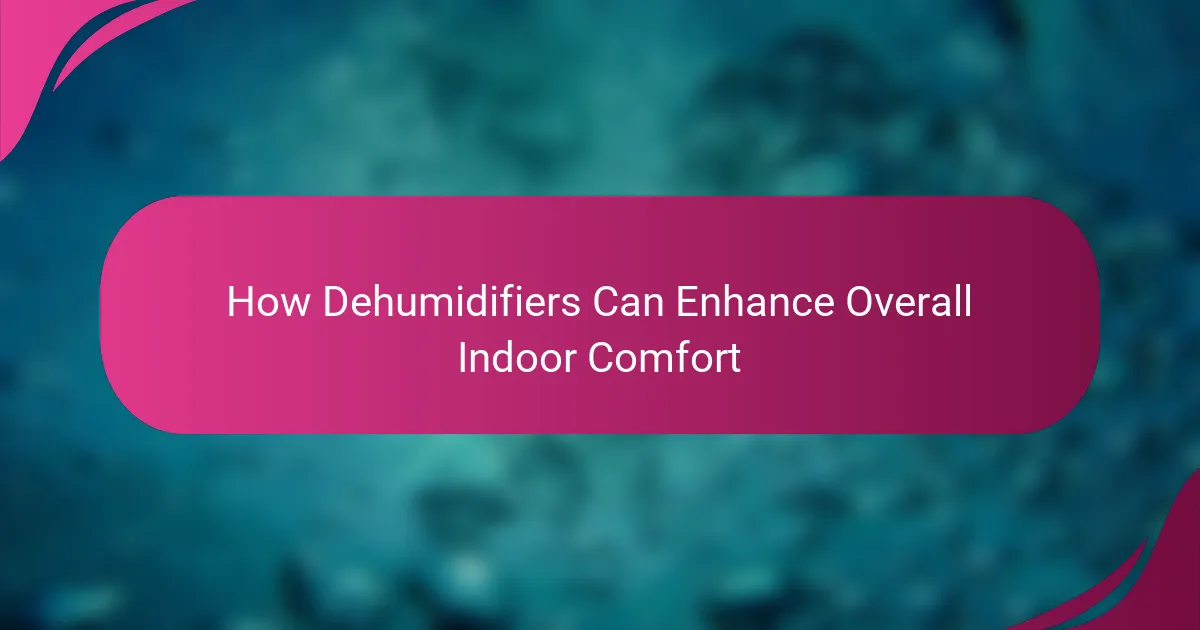Dehumidifiers play a crucial role in enhancing indoor comfort by effectively reducing excess moisture in the air, which can lead to health issues and discomfort. By maintaining optimal humidity levels, they not only improve air quality but also protect your home and belongings from moisture-related damage, creating a healthier living environment, especially in humid regions. In Canadian climates, selecting the appropriate type of dehumidifier is essential for optimal performance based on specific environmental conditions.

How do dehumidifiers improve indoor air quality in Canadian homes?
Dehumidifiers enhance indoor air quality in Canadian homes by reducing excess moisture, which can lead to various health issues and discomfort. By maintaining optimal humidity levels, they create a healthier living environment, particularly in regions with high humidity.
Reduction of allergens
Dehumidifiers help reduce allergens such as dust mites, pollen, and pet dander by lowering humidity levels, which can promote their growth. Keeping humidity between 30% and 50% can significantly decrease the presence of these irritants in the air.
For effective allergen control, regularly clean or replace the dehumidifier’s filter and ensure it operates efficiently. This maintenance helps trap airborne particles and improves overall air quality.
Prevention of mold growth
High humidity levels can create an ideal environment for mold growth, which can cause respiratory issues and damage to property. Dehumidifiers maintain humidity levels below 60%, effectively preventing mold spores from thriving.
To maximize mold prevention, position the dehumidifier in damp areas such as basements or bathrooms. Regularly monitor humidity levels with a hygrometer to ensure they remain within the safe range.
Control of humidity levels
Controlling humidity levels is essential for comfort and health. Dehumidifiers can automatically adjust their operation based on the humidity readings, ensuring consistent air quality throughout the home.
For optimal performance, choose a dehumidifier with a built-in humidistat. This feature allows the unit to turn on and off as needed, conserving energy while maintaining a comfortable indoor environment.

What are the benefits of using a dehumidifier?
Dehumidifiers offer several advantages that enhance indoor comfort by reducing excess moisture in the air. They help create a more pleasant living environment, improve air quality, and protect your home and belongings from moisture-related issues.
Enhanced comfort
Using a dehumidifier can significantly improve indoor comfort levels by reducing humidity, which often leads to a stuffy and oppressive atmosphere. Lower humidity levels make it feel cooler during warmer months, allowing you to maintain a comfortable temperature without relying heavily on air conditioning.
For optimal comfort, aim for indoor humidity levels between 30% and 50%. This range helps prevent the growth of mold and dust mites, which thrive in higher humidity, thus contributing to a healthier living space.
Energy efficiency
Dehumidifiers can enhance energy efficiency by allowing your air conditioning system to operate more effectively. When humidity is reduced, air conditioning units do not have to work as hard to cool the air, leading to lower energy consumption and reduced utility bills.
Consider using a dehumidifier in conjunction with your HVAC system, especially in humid climates. This combination can lead to energy savings of up to 20% on cooling costs, making it a smart investment for long-term comfort and efficiency.
Protection of furniture
Excess moisture in the air can damage furniture, electronics, and other belongings by promoting mold growth and causing warping or deterioration. A dehumidifier helps maintain a stable humidity level, protecting your investments from moisture-related damage.
To safeguard your furniture, especially wooden items, keep indoor humidity below 50%. Regularly monitor humidity levels with a hygrometer to ensure your home remains a safe environment for your belongings.

Which dehumidifier types are best for Canadian climates?
In Canadian climates, both refrigerant and desiccant dehumidifiers can effectively manage humidity levels, but their performance varies with temperature and moisture conditions. Choosing the right type depends on the specific environment, such as whether it’s a cold basement or a warmer living area.
Refrigerant dehumidifiers
Refrigerant dehumidifiers are ideal for warmer months and work by cooling air to condense moisture, making them effective in humid conditions. They typically operate best in temperatures above 15°C (59°F) and can remove significant amounts of moisture from the air, often in the range of 20 to 50 liters per day.
When selecting a refrigerant dehumidifier, consider the size of the space and the unit’s capacity. For larger areas, look for models with higher extraction rates. Be mindful that these units can struggle in colder temperatures, so they may not be suitable for unheated spaces during winter.
Desiccant dehumidifiers
Desiccant dehumidifiers use hygroscopic materials to absorb moisture from the air, making them effective in lower temperatures, typically below 15°C (59°F). They are particularly useful for cold basements or areas with fluctuating humidity levels, as they can operate efficiently even in cooler conditions.
When choosing a desiccant dehumidifier, consider its moisture absorption capacity and the size of the area you need to dehumidify. These units generally have lower extraction rates compared to refrigerant models, often around 10 to 20 liters per day, but they excel in colder environments where refrigerant units may fail.

How to choose the right dehumidifier for your home?
Selecting the right dehumidifier for your home involves considering factors such as room size, energy efficiency, and noise levels. These elements will help you find a unit that effectively reduces humidity while fitting your lifestyle and budget.
Room size considerations
When choosing a dehumidifier, the size of the room is crucial. Units are typically rated for specific square footage, so it’s essential to measure your space and select a model that can handle the humidity levels effectively. For example, a small dehumidifier may suffice for a bathroom, while a larger unit is necessary for a basement or open living area.
As a general guideline, a unit that can remove 30-50 pints of moisture per day is suitable for rooms up to 1,500 square feet. For larger spaces, consider models that can handle 50-70 pints for areas between 1,500 and 2,500 square feet.
Energy efficiency ratings
Energy efficiency is another important factor when selecting a dehumidifier. Look for models with the ENERGY STAR label, which indicates they meet energy efficiency guidelines set by the U.S. Environmental Protection Agency. These units can help reduce electricity costs while maintaining effective moisture control.
Typically, energy-efficient dehumidifiers use less power, which can result in savings of up to 20-30% on your energy bill compared to standard models. Check the energy factor (EF) rating, which measures the amount of moisture removed per kilowatt-hour of electricity consumed, to compare efficiency across different units.
Noise levels
Noise levels can significantly impact your comfort, especially if the dehumidifier will be used in living spaces or bedrooms. Most models provide a decibel (dB) rating, which can help you gauge how loud the unit will be during operation. Generally, quieter units operate at around 40-50 dB, similar to a refrigerator.
Consider looking for dehumidifiers with a “quiet” or “sleep” mode, which reduces noise while maintaining performance. This feature is particularly beneficial for nighttime use, ensuring that you can enjoy a peaceful environment while the unit works to improve indoor air quality.

What are common misconceptions about dehumidifiers?
Many people misunderstand the role of dehumidifiers, believing they are only necessary in specific situations or that they are inefficient. In reality, dehumidifiers can improve indoor air quality and comfort in various environments, not just damp areas.
Dehumidifiers are only for damp basements
While dehumidifiers are often associated with damp basements, they are beneficial in any area with high humidity levels. Rooms like bathrooms, kitchens, and laundry areas can also benefit from reduced moisture, preventing mold growth and improving air quality.
Using a dehumidifier in living spaces can enhance comfort by maintaining optimal humidity levels, typically between 30% and 50%. This range helps reduce allergens and creates a more pleasant environment throughout the home.
They consume too much energy
A common belief is that dehumidifiers are energy hogs, but many modern units are designed to be energy-efficient. Look for models with the Energy Star label, which indicates they meet strict efficiency guidelines and can significantly lower energy costs.
In practice, the energy consumption of a dehumidifier can vary based on its size and usage. A typical unit may use between 300 and 700 watts, translating to a modest increase in your electricity bill, often just a few dollars per month, depending on usage patterns.

How do dehumidifiers contribute to overall indoor comfort?
Dehumidifiers enhance overall indoor comfort by reducing excess moisture in the air, which can lead to a more pleasant living environment. By maintaining optimal humidity levels, typically between 30% and 50%, they help prevent discomfort, mold growth, and allergens.
Improved sleep quality
Dehumidifiers can significantly improve sleep quality by creating a more comfortable sleeping environment. High humidity levels can cause discomfort, leading to restless nights and difficulty falling asleep.
By lowering humidity, dehumidifiers help regulate body temperature and reduce sweating, allowing for a more restful sleep. It’s advisable to set your dehumidifier to maintain humidity levels around 40% to 50% for optimal sleep conditions.
Consider placing the dehumidifier in your bedroom or using a portable unit to target specific areas. Regular maintenance, such as cleaning the filter and emptying the water tank, ensures it operates efficiently and effectively enhances your sleep quality.
